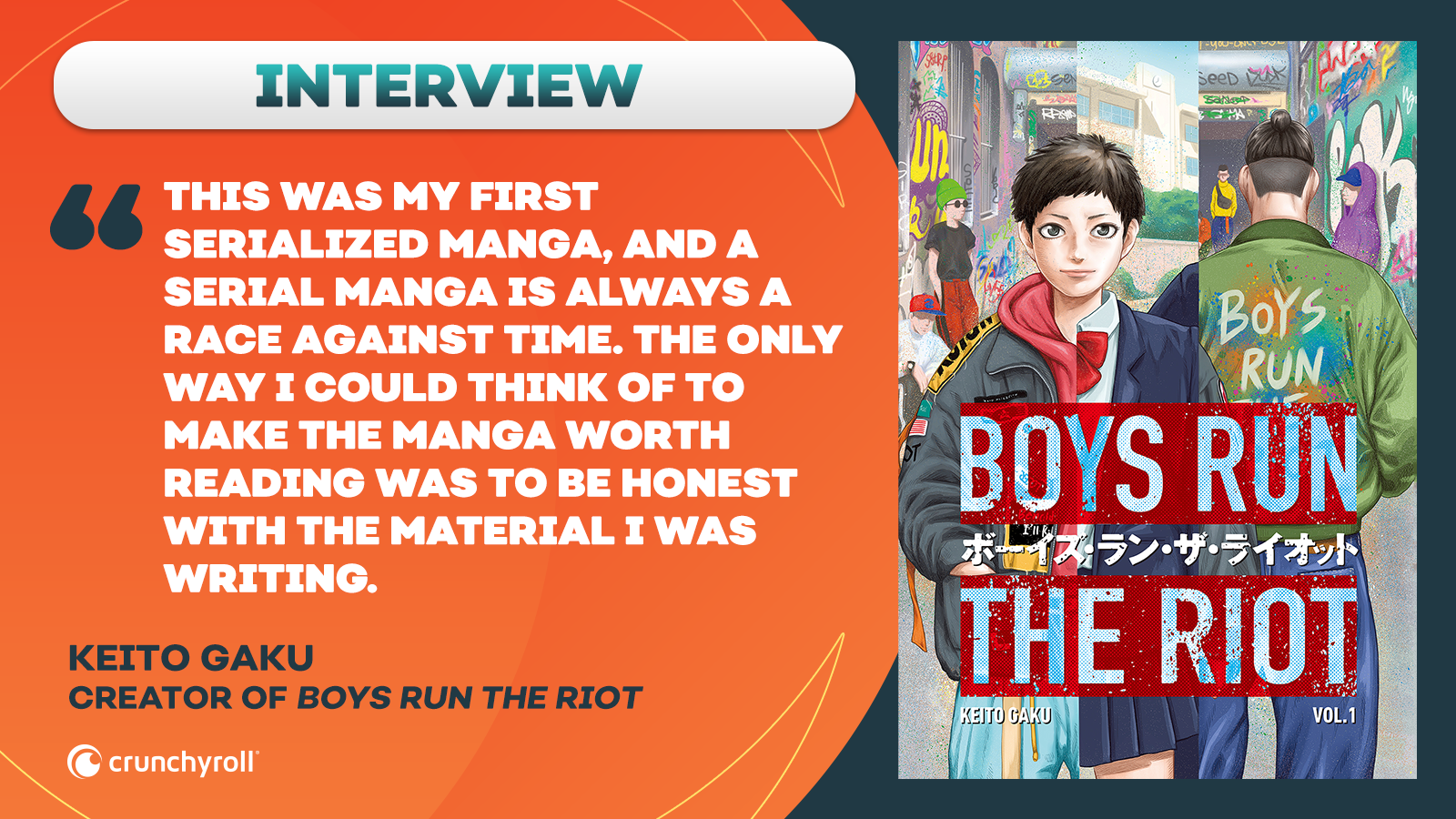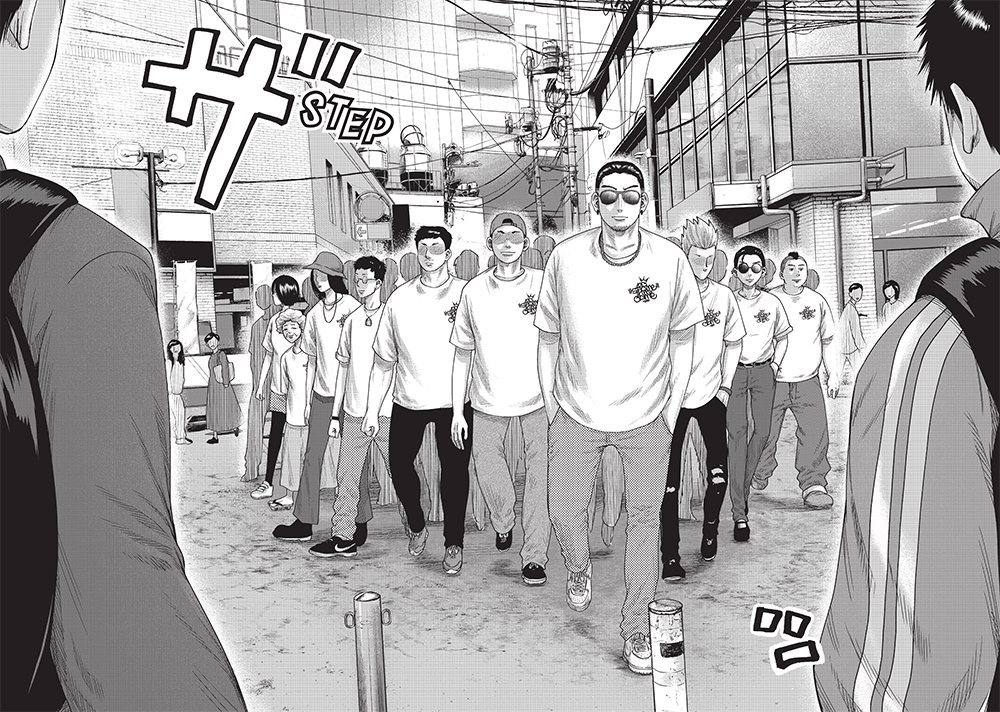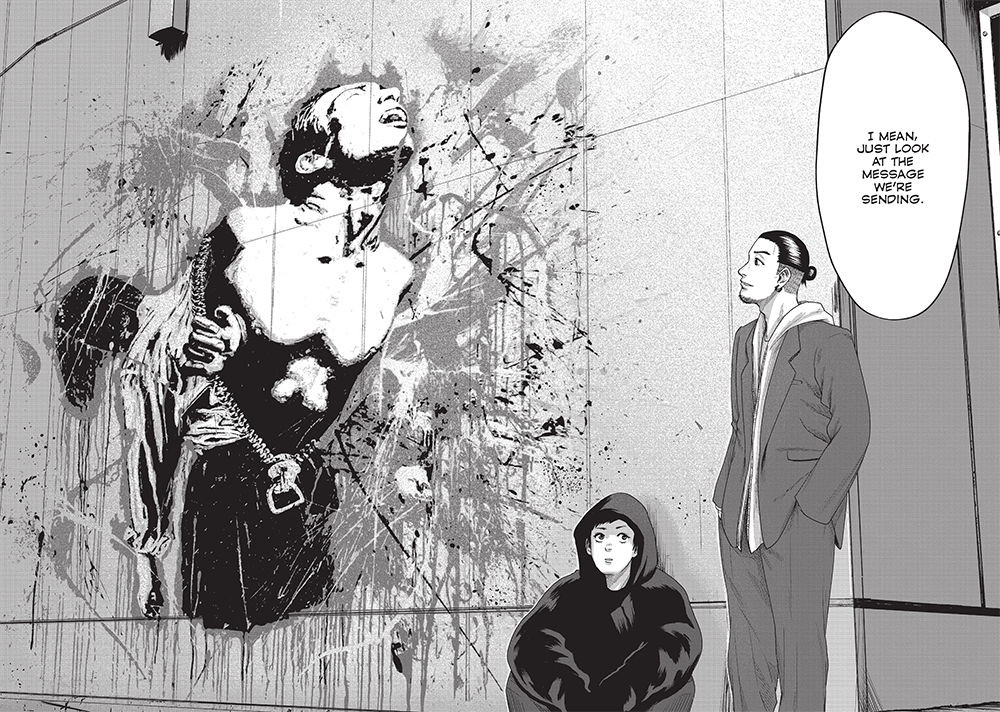
Boys Run the Riot is a manga about a transgender high school student named Ryo and his journey to enter the world of street fashion ... and it's one of my favorite manga in recent memory. Within the first few pages, you're hit by the impact of its storytelling. The opening color panels depicting Ryo spraying graffiti art over his school uniform are immediately striking, setting up the sense of oppression and shame he feels towards a uniform that doesn't match his identity but also the power of art to transform this pain into something freeing and beautiful.
Thanks to our friends at Kodansha Comics, we had the pleasure of interviewing the manga's creator, Keito Gaku, about his work on the series just in time for LGBT Pride Month. Gaku talked with us about the origin of the title, streetwear, and the ways his own experiences have informed the stories of Ryo and his friends.
SPOILERS AHEAD! This interview spoils certain plot points in Volume 1 of Boys Run the Riot.

Could you talk a bit about how you chose the title Boys Run the Riot? What led you to choose an English title instead of one in Japanese?
I spent a lot of time agonizing over the title, so I don’t really remember exactly where I got the idea ... I do know that I spent a lot of time talking with my editor before finally settling on it.
You’ve spoken before1 about how Boys Run the Riot draws deeply from your own experiences, and experiences that other people have shared with you. How much of yourself is in the protagonist, Ryo?
What happens to Ryo isn’t directly inspired by my own life, but how he feels and reacts when he encounters the events in the story is often just what I would feel or think if I was in his shoes.
The scenes of Ryo experiencing gender dysphoria are very impactful — Ryo saying that he wanted to destroy his right hand after his coworker was holding it was particularly painful to read. Was it difficult to put these sorts of experiences into the manga?
This was my first serialized manga, and a serial manga is always a race against time. The only way I could think of to make the manga worth reading was to be honest with the material I was writing. So looking back, it wasn’t painful so much as it was a desperate attempt to get it all out and onto the page in time.
Are you personally interested in streetwear? What made you focus on fashion as the main aspiration for the protagonists?
I needed a place where the main character could take the gender-related issues they’re suffering from and turn them into a strength that was theirs and theirs alone. I had a lot of different ideas for what that could be, and ended up choosing the world of fashion. There are fashion brands that place an emphasis on being genderless, and it felt like a place where a different approach towards gender than most people could actually be an advantage.
I enjoy buying and wearing clothes as much as the next person, but I didn’t know that much about it when I started. However, as I did my research, I started to learn more about streetwear and designing brands, and how fascinating a field it was. I think making this manga has gotten me more interested in fashion.

Many LGBTQ people in the West have gravitated towards manga and anime because, until recently, there has generally been much more gender and sexuality variance there than in Western media. What is it about manga that makes it a good medium to explore LGBTQ topics?
I’m hearing this for the first time, actually. But I think with manga, the author has a great deal of creative freedom to draw what they want, and readers are free to consume only stories that interest them. This makes it hard for there to be a lot of nasty criticism and censorship.
One of the most moving scenes of volume one depicts Ryo coming out to Jin, leading to the amazing full spread reveal of Ryo’s graffiti art. Could you talk a bit about how you planned out such an impactful scene?
I didn’t want the scene to just be about starting a new brand. When I was trying to figure out what the two of them would be trying to accomplish, and what kind of clothes they’d be making, I wanted to have a scene where they actually created something. Graffiti art as a medium is very cool to look at, and also has its roots in giving a voice to the voiceless, so I thought it was appropriate for Ryo.

Watching Ryo build a group of friends he can trust and be open with is incredibly touching. Did you find it important to depict Ryo’s support circle, not just his pain?
I thought it was extremely important. There are scenes in the manga where Ryo feels painfully alone, but a lot of the time, he’s surrounded by friends and not thinking about gender at all. In a sense, you never really “solve” your gender problems, but having people that you can open up to is, I think, the way to to overcome your struggles.
Jin is such a fascinating character! What was the inspiration behind such a rebellious yet supportive character?
Ryo is introverted and has trouble expressing who he is, so I wanted his partner to be his opposite. That’s how I came up with the outgoing, free-spirited Jin, who’s always true to himself.
I think it’s great having X-gender2 characters like Kashiwabara appear in the story. What made you decide to have both binary transgender and X-gender characters in your manga?
I wanted to make it a story not just about transgender characters, but a variety of different identities. That’s why I wanted a character who struggles with a non-binary gender identity. Ryo puts a heavy importance on the fact that he’s male, so having Tsubasa’s character is important for showing the story’s stance.

Lastly, is there any parting message you would like to share with fans of Boys Run the Riot or to transgender fans of manga in general?
Thank you for picking up Boys Run the Riot.
Having transgender and LGBTQ+ readers contact me via social media and reading how much they enjoyed the story is an inspiration for me, and makes me glad I got the opportunity to create this book.
If I ever get the chance to write another manga, I hope you’ll read it as well.
Boys Run the Riot © Keito Gaku/Kodansha Ltd.
1This is referencing an interview with Gaku conducted by Kodansha Comics. You can read the entire interview in Kondansha's US publication of the first volume of Boys Run the Riot.
2X-Gender is a term denoting non-binary gender identity that originated in Japan. Most reading and resources on the term are in Japanese, like this Job Rainbow explainer article.
Boys Run the Riot is published by Kodansha. Check out kodansha.us/series/boys-run-the-riot/ if you want to pick up some of the volumes!
-------
Cayla Coats tweets @ceicocat. You can watch her rarely updated YouTube channel here.
Source: Latest in Anime News by Crunchyroll!

Comments
Post a Comment